|
|
|
| ||
| Español |
Currently only excerpts & illustrations from the last 13 issues (numbers 43 to 55) are on this site. Scroll down to view the March 1998 issue. Click on the numbers to view other issues. Info about the current book on the arts | |||||||||||||||||||||||||||||||||||||||||||||||
| Contents List | |||||||||||||||||||||||||||||||||||||||||||||||
| excerpts & illustrations (The full articles are only available in the printed magazine. Click on "subscribe" for more info.) |
 |
56 |  |
55 |  |
54 |  |
 |  |
53 |  | 52 |  |
51 |  |
 |
 |
50 |  |
49 |  |
48 |  |
47 |  |
 |  |  |  |
 | ||||||||||||||||||
 |
 |  |
 | ||||||||||||||||||||||||||||||||||||||||||||
| 46 |  |
45 |  | 44 |  |
43 |  |  |
 | 42 |  | 41 |  | 40 |  | 39 |  |
 | 38 |  | 37 |  |
36 |  | 35 |  |
 |  |
34 |  |
33 |  | 32 |  | 31 |  | |||||||||||
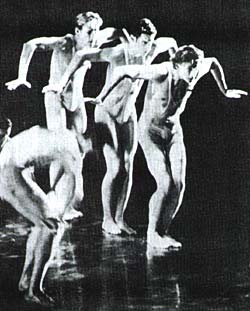
"The Joffrey Ballet of Chicago perform Initiation", 1997. Reviewed by Joseph Houseal, U.S.A. Photo: |
|
March 1998
|
Outside / Inside - Documenta ,
|
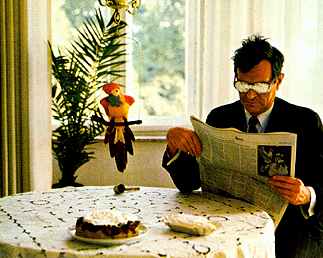 Still
from the film, Berlin or a Dream with Cream,
Still
from the film, Berlin or a Dream with Cream,by Marcel Broodthaers (1924-1976, Belgium). ...there was a broad representation of the Belgian Marcel Broodthaers' work, with photos, slide projections and a video interview with the artist, so the visitor felt welcome to explore his world. Unfortunately it was situated by an entrance, so it was not physically possible to pause for a work that had a lot to offer. For me, his work was one of a handful that really fitted David's theme of the poetic and political. Broodthaers' 'museum of eagles' was poeticising and politicising, through his tongue-in-cheek use of popular images... |
Was there some sort of message? And if not, then what made this exhibition
any different from one that used sensationalism as a ploy? |
|

image to come..., |
|
...excerpts to come..... |
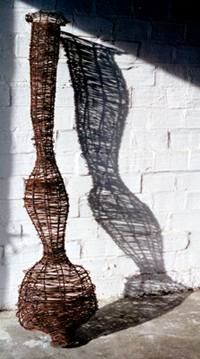
Filet by Christophe Doucet, 1994, woven wire, France. |
| |
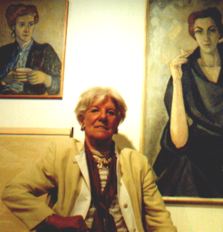
Miep Diekmann |
In this interview Miep Diekman focuses on her coaching writers from Curaçao and Aruba, and her novel set in the Dutch slave trade.
|
This detective story is based around a national clean up action on Curacao, where a group of 7 or 8 year olds are the main characters. The story begins with a
photographer attempting to get the crowd to disperse so he can take a clear shot of the old woman, Cirila's heap of old furniture, plastic containers, and so on.
Slogan-like phrases throughout the dialogue give the effect that everyone is involved in this action in one way or another...
|
|
...Another problem I had with the English translation, which is roughly half the size of the Dutch version, was the scene where Oeba forces Knikkertje to put her own party dress at her 15th birthday party, which shocks Oeba's prospective husband Floris, and the guests, and results in having Knikkertje moved to the slave quarters.
Here Oeba's desire to share with Knikkertje is so strong that it does harm, but it is also illustrates the deepness of prejudice. Here Knikkertje was the belle of the ball, and Floris's reaction was to scream in horror. For me this is the crucial point of the story. Knikkertje is in Oeba's dress, but she is not the same as Oeba. The publisher had already said that the book had to be much smaller to fit into a series, and I was happy about editing it myself (a whole chapter about the Indians and their relationship with the slaves is omitted) as I had done the same with the French version. But now the publisher said that this part had to come out. |

"The Slave Doctor" -William Morrow and Company, N.Y., 1970.) . Drawn by Dick de Wilde from the 1990 edition, Leopold Publishing, The Netherlands. |
|
This was in 1970 and I had just been in Curacao and had been involved with the Black Power there, so I was
sensitive about these issues and said no. Then publisher said that they had an African American editor who agreed that it should come out. I felt this was discrimination,
so I said that I would cancel the contact if this part was omitted. It was printed but it didn't sell very well...
|
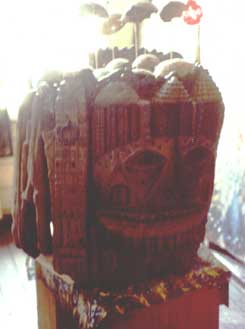 Carving by Philip Moore, Berbice, Guyana.
Carving by Philip Moore, Berbice, Guyana.
|
...This relates to the theme in my book about the slave trade too. If something goes wrong it is due to something being wrong with the way the economics of a
society is set up. During the slave trade multinationals governed the ethics and functioning of a society...
|
.....excerpts to come.........
|
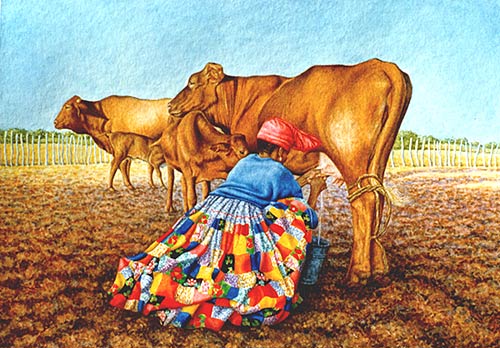
.....image to come....... |
|
|
Article |
Photographs and Illustrations of work by:
Elena Ostrer , Russia,
Carolynn Newport, Australia, David Taylor , U.S.A.,
Mary Jane Volkmann, Namibia, Philip Moore, Guyana,
Christophe Doucet , France, Sjra Marx, The Netherlands,
Ropata Davis , Aotearoa - New Zealand,
Taraneh Mozoun, The Netherlands, Bruno Maximus, Finland,
Heiko Schulze, Germany, P. Kouslita, Albania, Juul Sadée, The Netherlands.
Translations, editing, co-ordination, layout, by:Kathleen Babb, Japan, Alison Marshall, Aotearoa / New Zealand, Steve Marshall, Aotearoa / New Zealand, Sonja van Kerkhoff, The Netherlands. |
|
Arts Dialogue, Dintel 20, NL 7333 MC, Apeldoorn, The Netherlands
http://Bahá´í-library.org/bafa email: bafa@bahai-library.com |